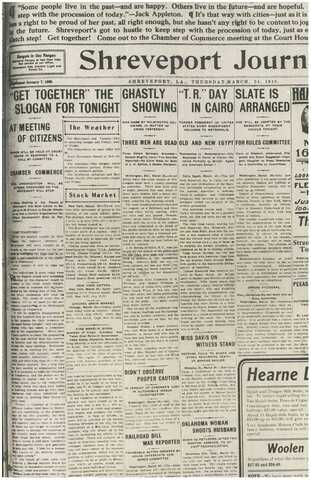
Chamber & Area History
Friday, March 25, 1910
With the express purpose of fostering progress and the betterment of the city of Shreveport, 500 businessmen of the community gathered the night of March 24, 1910, in the Caddo Parish Courthouse with the foresight to form an organization that would last for generations to come.
The meeting drew businessmen from many industries with the purpose of consolidating other commercial and public organizations throughout the city into one, more powerful entity that would be representative of the group as a whole.The group jumped into action immediately, forming the Shreveport Chamber of Commerce, raising $10,000 on the spot to start the organization, electing a president, E.K. Smith, and deciding on a 25-member board of directors.
The meeting was heralded by local newspapers as one of the most enthusiastic meetings held in the city. One of the main initiatives the businessmen were hoping to accomplish was better railroad rates, to break down the rate walls around Texas and Arkansas “whose shadows keep out the sun of prosperity and hold back the commercial supremacy of Shreveport.”
To this affect, after its formation the Chamber hired an expert rate officer to do just that, as well as an assistant to help bring in new industry to grow Shreveport. Investors were assured once trade barriers were taken down their products could be marketed successfully to new areas.On that night, one supporter proclaimed: “The Chamber of Commerce will be the embodiment of the best thought and efforts of our people for growth and progress. Its purpose will be as broad as the commercial and financial needs of the city and its watchword ‘Greater Shreveport.”‘The Shreveport Times article stated: “And when the gathering came to a close Shreveport was assured a commercial organization which has the backing of every local interest and with ample funds with which to carry out its purpose.”
History of Shreveport
Provided by historian Eric Brock
Shreveport, Louisiana, was founded in 1836 by the Shreve Town Company, a corporation established to develop a town at the juncture of the newly navigable Red River and the Texas Trail, an overland route into the newly independent Republic of Texas and, prior to that time, into Mexico.
The Red River had been cleared by Captain Henry Miller Shreve, commanding the U.S. Army Corps of Engineers, of the 180 mile long raft of debris that had clogged its channel since time immemorial. In Shreve’s honor the Shreve Town Company and the village of Shreve Town were named. On March 20, 1839 the village of Shreve Town was incorporated as the town of Shreveport. In 1871 Shreveport was incorporated as a city. The city’s original boundaries were contained within a parcel of land sold to the Shreve Town Company by the indigenous Caddo Indians in 1835. In 1838 Caddo Parish (county) was carved out of Natchitoches Parish and Shreve Town became the parish seat; Shreveport remains the parish seat of Caddo Parish, Louisiana today.
The original townsite consisted of 64 city blocks divided by eight streets running west from the Red River and eight streets running south from Cross Bayou, a tributary of the Red River. Today this 64-block area is the city’s central business district listed on the National Register of Historic Places.
Shreveport, and its smaller sister city, Bossier City (founded in 1884 and incorporated in 1907) together have six historic districts and many landmarks listed on the National Register. In fact, Shreveport is second only to New Orleans among Louisiana cities with multiple historic landmarks. One of these is the McNeill Street Pumping Station, an 1887 waterworks that is still in use and is the unique example of its type in the nation. It is listed on the National Historic Landmarks list, the highest level of national historical designation. Also located in metro Shreveport is Barksdale Air Force Base, opened in 1933 as Barksdale Army Air Field. It is also a national landmark.
The Red River, opened by Shreve in the 1830s, remained navigable until 1914 when disuse, owing to the rise of the railroad as the preferred means of transporting goods and people, allowed it to begin silting up. Not until the 1990s was navigation of the river again possible to Shreveport. Today the Port of Shreveport-Bossier is being developed once again as a shipping center.
More About The Chamber
Spotlight on Southern Air-Shreveport: Heating, Cooling, Plumbing, and Electrical with Heart
When it comes to comfort, reliability, and skilled craftsmanship, Southern Air – Shreveport delivers with excellence. Located at 9700 Saint Vincent Ave, Shreveport, LA, this branch of the well-known Southern Air brand brings exceptional HVAC, plumbing, electrical, and...
Spotlight on Southern Luxe Co: Shreveport’s Newest Destination for Style, Charm, and Southern Flair
If you're looking for the perfect mix of on-trend fashion and meaningful gifts, look no further—Southern Luxe Co is bringing fresh style and personality to Shreveport’s boutique scene. A locally owned and operated gem, Southern Luxe Co is quickly becoming the go-to...
Spotlight on HOTWORX Shreveport – Line Ave: Turning Up The Heat On Fitness.
Shreveport, Louisiana is turning up the heat on fitness with a bold new way to work out. HOTWORX- Shreveport, LA (Line Ave) is shaking up the local scene by delivering fast, effective, and seriously energizing workouts. Using cutting-edge infrared technology combined...
Summer Starts Here: Don’t Miss the WhataSUMMER Bash!
Kick off summer the fun way! Join us on Tuesday, June 10 from 5–8 PM for the WhataSUMMER Bash at participating Whataburger locations in Shreveport, Bossier City, Ruston, and Monroe. Enjoy a summer craft, family fun, and a free Kid’s Meal (Justaburger or Whatachick’n...
